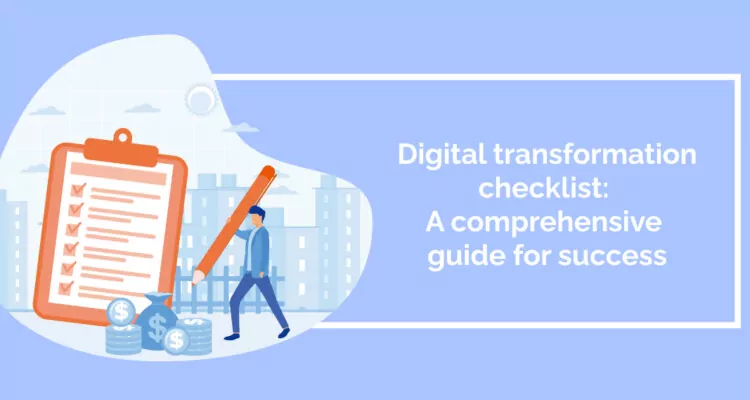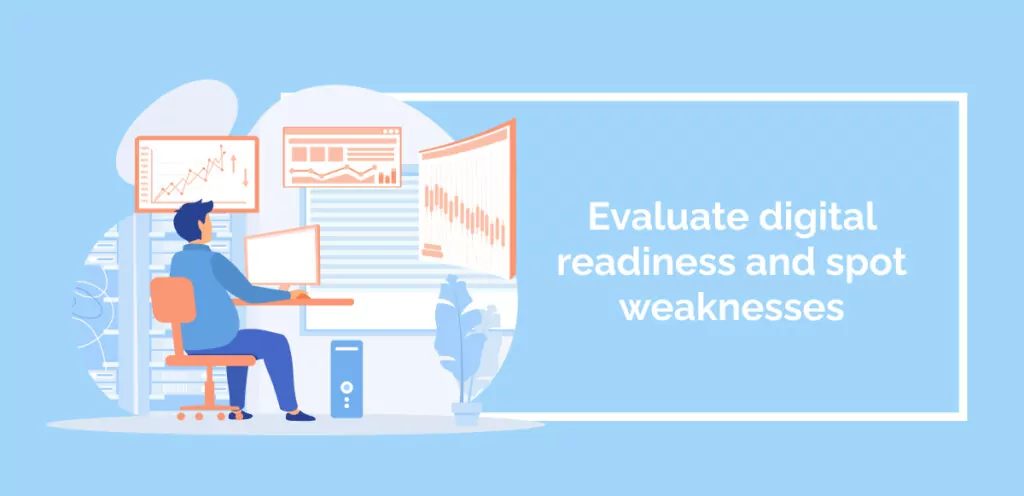
A digital transformation checklist is essential because it provides a structured approach to your digital overhaul. It identifies key steps, ensuring no crucial aspect is overlooked. This checklist aids in maximizing operational efficiency, improving customer experience, and driving business growth, making your digital transformation journey seamless and successful.
A digital transformation plan should go beyond simply updating systems and refreshing apps to keep pace with technological advancements—it’s not that straightforward.
To succeed in the digital transformation process, one must consider various aspects, particularly the human side. It’s not just about the tech—it’s about transforming how people think, the company culture, and how business is done.
Overlooking these critical elements can lead to problems with how new systems are embraced, how effectively people communicate, and how smoothly the business runs, all of which can weaken your position in the market.
Throughout this guide, you will explore elements that will make up your digital transformation checklist to ensure your success in this transition.
What is a digital transformation checklist?
A digital transformation checklist is a strategic tool designed to guide organizations through the process of integrating digital technologies into all areas of their business. It provides a structured roadmap to transform and digitize business operations, improve customer experiences, and adapt to an ever-changing digital economy.
Key elements typically include defining a clear vision and objectives for the transformation, understanding the organization’s current digital maturity, and identifying key drivers of digital change.
Let’s take a closer look:
How to create a digital transformation checklist

To effectively manage the intricate digital transformation journey, you need a carefully crafted plan and a precise grasp of every necessary action.
Adopt this step-by-step checklist to gauge your organization’s preparedness for digital change and to develop a winning approach:
Craft your digital vision and goals

Start with a crystal-clear vision and pinpointed goals that tie into your business’s broader ambitions. This vision will be your North Star, keeping you on course through the transformation and aiming your efforts at the desired results.
Here’s a checklist of what to think about at this stage:
- Pin down what’s driving your move toward digital or your readiness for change.
- Figure out how going digital can sharpen your competitive edge.
- Ensure everyone involved gets the vision and goals, from your team to your customers and partners.
Evaluate digital readiness and spot weaknesses

Know where you stand digitally. Compare your tech, methods, and abilities to what’s out there, and spot where you fall short.
This means that you need to:
- Do a deep dive into your digital readiness, checking your tech backbone, data smarts, customer handling, and team culture.
- Rank the weak spots by how fixing them could boost your business.
- Set a ‘before’ snapshot to track your transformation progress.
Strategize your digital overhaul

With a firm grasp of your digital status and a clear destination, chart out a strategy. This is your blueprint for the tech and changes you’ll need to fill those gaps and hit your goals.
So, it is essential to:
- Pick the digital tools and skills you need to drive transformation efforts.
- Stack your initiatives by impact and doability.
- Map out the steps and timeline for each part of your plan.
- Budget and allocate the resources to make it happen.
Get top-level backing

Digital change is significant—you’ll need the top brass in your corner. They can rally the troops, tackle roadblocks, and ensure you have what you need to succeed. It’s essential for leaders to grasp the reasons behind integrating new digital technologies and to see how these innovations will bolster their business goals.
To drive this change, you need to:
- Win over the top execs and lock in their support for your digital vision and plan.
- Put together a dedicated team to steer this type of change management in digital transformation, possibly with a Chief Digital Officer at the helm.
- Have the top sponsors spread the word on why this digital shift matters, tying it back to key business goals.
Cultivate innovation and nimbleness

Going digital means reshaping your culture to prize innovation, speed, and continuous progress.
Do this by:
- Encouraging teams to team up across the board, pooling their brainpower to innovate and solve problems.
- Rewarding those who think outside the box and take intelligent risks.
- Using agile ways of working to stay quick on your feet and ready for what’s next.
Invest in top-notch tech, frameworks, and people

You’ll need to put money into the latest tech, solid systems, and people with the right skills.
So, the actions you will need to take involve:
- Scanning the tech horizon for the best fit for your strategy.
- Building a sturdy infrastructure with cloud services, data storage, and top-tier security.
- Filling in the skills gap by hiring pros in data science, AI, and UX.
- Ensuring continuous learning for your crew through embracing digital adoption to keep them sharp and digitally savvy.
Make customer experience king

Customers should be at the heart of your digital shift. Use digital tools to get them exactly what they want, how they want it.
This means that you should:
- Do your homework on what customers are looking for.
- Draw up a customer-first digital plan with moves that will improve their experience with you.
- Use analytics and CRM systems to get the complete picture of your customers and customize your services.
- Keep a close eye on customer feedback to keep improving.
Train your team for the digital world

As digital tools evolve, so must your team.
Give them the training to stay ahead by:
- Gaining a deeper understanding of your team’s skillset and identifying areas that require improvement.
- Rolling out training to fill in the digital blanks, like data crunching, coding, and digital marketing.
- Encouraging continuous learning with an ongoing micro-training program. For example, building a culture and mindset dedicated to ongoing learning and innovation can smooth the path for your digital transformation initiatives.
- Building an environment where learning is part of the job, sharing is encouraged, and innovation is celebrated.
Lock down your data

In a world of digital risks, keeping data safe and staying on the right side of privacy laws is non-negotiable.
Ensure your workplace stays secure by:
- Evaluating the risks and know where you’re vulnerable.
- Crafting and enforcing a data security game plan with all the defenses—encryption, access checks, regular check-ups.
- Educating your team on keeping data safe and make sure they know the stakes.
- Staying on top of new threats and keep your data defenses up to date.
Measure, tweak, and enhance continuously

Continuously monitor the progress of your digital transformation journey, closely observing the outcomes and making necessary adjustments along the way. This proactive approach ensures that you stay on track and achieve optimal results.
This last step is your checklist is done by:
- Setting KPIs that line up with your digital goals and reflect real business benefits.
- Bringing in analytics tools to watch your progress live.
- Regularly reviewing how you’re doing, celebrate wins, learn from the less-than-wins, and spot new chances to get better.
- Adapting your plan in line with real-time data insights and changing market conditions.
Critical takeaways from your digital transformation checklist
Digital transformation disrupts industries by extensively revising a company’s purpose to conform to the digital business environment and requires total organizational engagement.
A well-crafted digital transformation checklist guides successful change and prompts essential dialogues among executives about the organization’s current state and required advancements to increase digital maturity.
The checklist also serves as a benchmarking tool, enabling comparisons with industry leaders and allowing companies to ascertain their competitive standing and devise strategic plans.
Remember, digital transformation is continuous, necessitating adaptability for enduring success.
WalkMe Team
WalkMe spearheaded the Digital Adoption Platform (DAP) for associations to use the maximum capacity of their advanced resources. Utilizing man-made consciousness, AI, and context-oriented direction, WalkMe adds a powerful UI layer to raise the computerized proficiency, everything being equal.



